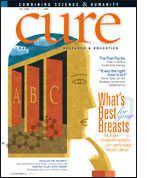Publication
Article
CURE
What's the Right Decision?
Author(s):
The growing need for shared decision-making in medicine.
I once heard a thought leader in health care, Paul Wallace, MD, of Kaiser Permanente, say the first major revolution in medicine occurred when Gutenberg invented the printing press. Suddenly medical students, and not just their professors, had “The Book” of medical knowledge. The second revolution was the advent of the Internet, where now patients have The Book.
Having access to The Book changes the ageold asymmetry between physicians and patients. Patients can now find information online. Access to information should make decision-making easier, right? We should be headed into an age in which all our medical decisions will be obvious, right?
Wrong. We are culturally disposed to believe that “if I only had all the information, it would be easy to make a decision.” We’ve inherited this attitude from centuries of information scarcity, where statisticians labored in academic coal mines to wring every ounce of inference out of very expensive data. When information was scarce, it seemed like the most valuable asset in making decisions.
Soon, information will be plentiful and cheap. Michael Lewis, in his book Moneyball, describes how, when journeymen shortstops began to command million-dollar salaries, baseball began tracking the outcome of every play in order to evaluate the effectiveness of those shortstops. We are reaching a point in our economy where we spend so much on medical procedures that it will make economic sense for us to track every outcome of every medical intervention in order to determine the effectiveness of our care.
In such an information age, we will realize that information, while valuable, does not make decisions easier. We may be able to narrow the range of uncertainty in many cases, but we will still need to weigh those risks and benefits.
For example, women at high risk of breast cancer may continue to consider prophylactic mastectomies for some time to come. Over time, we will have better information about the risks and benefits of such an approach to managing breast cancer risk. And we will have better information about the risks and benefits of waiting and then treating the breast cancer if and when it occurs. But the decision of whether to act now, or defer action, will not be an easy one, even when we have good information about each path.
This example illustrates that the essential dynamics of decision-making, which involve choosing between uncertain deals, do not change with the advent of more access to information.
The good news is that medicine can adopt proven approaches from other disciplines to cope with decision complexity. I was trained in one such approach, systems engineering. Engineers design and build bridges, space shuttles, data networks, and other pragmatic solutions to high-stakes, high-risk situations. Schools of engineering generally teach engineers how to weigh the risks and benefits of their designs and choose balanced solutions that are implemented collaboratively through complex data analysis and dialogue.
All this is also true in medicine, where a field of shared decision-making is emerging to formalize the theory and practice of collaboratively weighing risks and benefits to arrive at decisions that achieve an appropriate balance. I am optimistic that, just as other industries have transitioned from paternalism, hierarchy, and authority to distributed, collaborative decision-making, doctors and patients will find ways of coping with the coming era of complexity in medical decision-making.
—Jeffrey Belkora, PhD, is director of Decision Services at University of California, San Francisco Breast Care Center.






